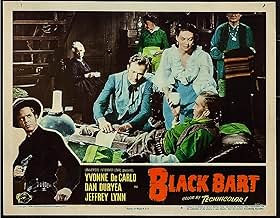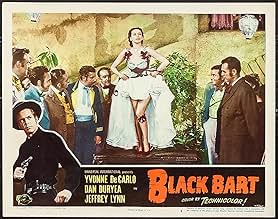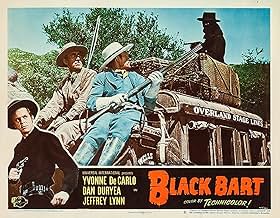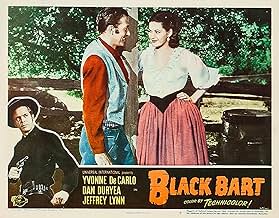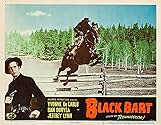CALIFICACIÓN DE IMDb
6.2/10
506
TU CALIFICACIÓN
Agrega una trama en tu idiomaCalifornia stage robber Black Bart meets European dancer Lola Montez.California stage robber Black Bart meets European dancer Lola Montez.California stage robber Black Bart meets European dancer Lola Montez.
- Dirección
- Guionistas
- Elenco
- Premios
- 2 premios ganados en total
Soledad Jiménez
- Teresa
- (as Soledad Jimenez)
Eddy Waller
- Ed Mason
- (as Eddy C. Waller)
Anne O'Neal
- Mrs. Harmon
- (as Anne O'Neil)
Eddie Acuff
- Elkins
- (sin créditos)
Earl Audet
- Townsman
- (sin créditos)
William Bailey
- Townsman
- (sin créditos)
Ray Bennett
- Henry
- (sin créditos)
Nina Campana
- Mamacita
- (sin créditos)
Opiniones destacadas
Dan Duryea is Charles Boles, a respectable rancher in Gold Rush California. He's also Black Bart, who holds up stage coaches. Wells Fargo has put a $10,000 reward on him. When his old confederates, Jeffrey Lynn and Percy Kilbride come to town, they take jobs with Wells Fargo. They're also working for themselves when they recognize Duryea and want in. However, Yvonne De Carlo has come to town -- she's Lola Montez -- and she and Duryea fall in love.
It's a highly entertaining and beautifully shot A western from Universal, directed by Henry Hathaway. It's also the ahistorical piffle that infused westerns. Lola Montez (real name: Marie Dolores Eliza Rosanna Gilbert, Countess of Landsfeld) was indeed in the US and performing on stage by about this time, she died in 1861. The real Charles Boles/Black Bart flourished as a stagecoach robber from 1875 through 1883, was captured, spent four years in prison, was released in bad health and disappeared. No one in Hollywood ever let a little thing lack facts get in the way of telling an amusing story.
The highlight is Miss De Carlo's dances as Montez. She had spent half a decade playing uncredited eye-candy roles in Hollywood, before shooting to recognition in SALOME WHEN SHE DANCED. I remember her as Lily Munster, of course, and as one of the cast in Sondheim's FOLLIES; like many a beautiful woman, she had a great sense of humor and comedy about her beauty. She died in 2007, age 84.
It's a highly entertaining and beautifully shot A western from Universal, directed by Henry Hathaway. It's also the ahistorical piffle that infused westerns. Lola Montez (real name: Marie Dolores Eliza Rosanna Gilbert, Countess of Landsfeld) was indeed in the US and performing on stage by about this time, she died in 1861. The real Charles Boles/Black Bart flourished as a stagecoach robber from 1875 through 1883, was captured, spent four years in prison, was released in bad health and disappeared. No one in Hollywood ever let a little thing lack facts get in the way of telling an amusing story.
The highlight is Miss De Carlo's dances as Montez. She had spent half a decade playing uncredited eye-candy roles in Hollywood, before shooting to recognition in SALOME WHEN SHE DANCED. I remember her as Lily Munster, of course, and as one of the cast in Sondheim's FOLLIES; like many a beautiful woman, she had a great sense of humor and comedy about her beauty. She died in 2007, age 84.
This film manages to be relatively non-formulaic, and even more non-historical, though the real Black Bart was indeed named Charles E. Boles as portrayed. British-born Boles, however, did not conduct his outlaw career as a Zorroesque black-clad horseman, but hiked to all his holdups and wore a long linen duster, with a flour sack over his head. He was also pushing 50 when he started robbing the stage. So much for a romantic image! If the intention was to make Bart/Boles a dashing figure, I think another actor would have been a better choice than Dan Duryea, who after all pretty much built his career on playing creeps. But it's always interesting to see a departure, and the script is more clever than that of the routine horse opera of the day.
As Lola Montez, Yvonne De Carlo makes no effort at a real characterization of the famous Countess (former mistress to Ludwig I of Bavaria), but acts-- well, like Yvonne De Carlo, delivering her lines in her usual flat New World tones. The witty, volatile and multilingual Lola (nee Eliza Gilbert), though Irish by birth, affected a sort of Spanish accent to go with her assumed Sevillian identity. De Carlo's dancing, I fear, bears little resemblance to Lola's, but it's always a pleasure to watch Yvonne in her early roles; this film came only three years after her dazzling debut in 1945's "Salome, Where She Danced", in which she played a quasi Lola Montez, thereby confusing the record considerably.
In reference to this: the real Lola never danced as Salome nor visited Arizona, and the town there called "Salome, Where She Danced" was named in 1904, and for quite another lady. To play Lola or a quasi-Lola, De Carlo does certainly fit the bill visually as a stunning blue-eyed brunette with a memorable figure. As to Lola ever encountering Black Bart-- well, when he began his career as a highway robber in 1875 Lola had been in her grave for fourteen years. So much for romance!
As Lola Montez, Yvonne De Carlo makes no effort at a real characterization of the famous Countess (former mistress to Ludwig I of Bavaria), but acts-- well, like Yvonne De Carlo, delivering her lines in her usual flat New World tones. The witty, volatile and multilingual Lola (nee Eliza Gilbert), though Irish by birth, affected a sort of Spanish accent to go with her assumed Sevillian identity. De Carlo's dancing, I fear, bears little resemblance to Lola's, but it's always a pleasure to watch Yvonne in her early roles; this film came only three years after her dazzling debut in 1945's "Salome, Where She Danced", in which she played a quasi Lola Montez, thereby confusing the record considerably.
In reference to this: the real Lola never danced as Salome nor visited Arizona, and the town there called "Salome, Where She Danced" was named in 1904, and for quite another lady. To play Lola or a quasi-Lola, De Carlo does certainly fit the bill visually as a stunning blue-eyed brunette with a memorable figure. As to Lola ever encountering Black Bart-- well, when he began his career as a highway robber in 1875 Lola had been in her grave for fourteen years. So much for romance!
Can you be disappointed if you had no expectations in the first place? In this case: yes. This less than a classic western has an above average idea it fails to deliver. The triangle romance between the zorro- like masked villain, the posing- as- a- good- guy villain and the European dancer- and- mistress- to- the- emperor- of- Austria- turned- saloon singer is actually quite original.
The film, however, is not. The standard western imagery and unimaginative cinematography/direction condemns this film into the "forgettable"- category. Still it must be noted that there is no hero in this western: just two outlaws and a corrupt dame. Although they get their due in the "grand" finale, themes like that are not frequent in the westerns of the classic era but associated usually to westerns in the late 60's and 70's.
The film, however, is not. The standard western imagery and unimaginative cinematography/direction condemns this film into the "forgettable"- category. Still it must be noted that there is no hero in this western: just two outlaws and a corrupt dame. Although they get their due in the "grand" finale, themes like that are not frequent in the westerns of the classic era but associated usually to westerns in the late 60's and 70's.
Gorgeous Miss De Carlo often portrayed historic figures:from Sephora to Calamity Jane and from La Castiglione to Lola Montès (spelled "Montez" ,unlike in Europa).Many users probably know Max Ophuls' last opus (1954) which showed a Lola short of the readies,(Martine Carol)who had to work in a circus -under a cynical MC 's Thumb played by Peter Ustinov) Lola was king of Bavaria LudwiG Der Erste 's lover (not to be mistaken for gay Ludwig Der Zweite)and in the movie,you can hear Lola talk about the jewels he bestows on her;"you look at my jewels the way the king used to look at me" ) The story is a bit tongue in cheek and the tale of this masked brigand is not particularly exciting but Lola adds some spice to it.
Three tricky outlaws part ways, only to meet up later on opposite sides.
Pretty good Western— somewhere between an A-production and a B. It's an unusually distinguished supporting cast from Lovejoy to McIntyre to Kilbride, along with some good scenic outdoor set-ups that keep the eye entertained even when the action slows down. Reviewer lorenellroy is right—the amorality of Lynn and Duryea is unusual for the period, 1948. It's hard at times to know where their loyalties lie, making the script somewhat—and refreshingly-- difficult to predict. Add a luscious De Carlo who looks ravishing in Technicolor, while turning in a surprisingly artful performance.
So, with these positives, why doesn't the movie impact more strongly than I believe it does. Now I'm as big a Duryea fan as anyone. In fact that's why I tuned in. But for some reason he looks less motivated than usual, draining Bart of needed character color. There's not the usual relish of his better performances. Add to that the other lead, Jeffrey Lynn, who's just naturally colorless, and there's not the needed drive at the movie's center. At the same time, director Sherman has to work in the romantic angle without sagging the tempo, which he does pretty well. But the staging of the final ambush scene is clumsily done—how could the ambushers miss their shots at such close range as Bart and Lance race for the cabin.
Anyway, there's real offbeat potential in the various ambiguities that the script doesn't develop adequately until the end. Nonetheless, the compensations are enough to make this a generally entertaining 80-minutes of cowboy intrigue.
Pretty good Western— somewhere between an A-production and a B. It's an unusually distinguished supporting cast from Lovejoy to McIntyre to Kilbride, along with some good scenic outdoor set-ups that keep the eye entertained even when the action slows down. Reviewer lorenellroy is right—the amorality of Lynn and Duryea is unusual for the period, 1948. It's hard at times to know where their loyalties lie, making the script somewhat—and refreshingly-- difficult to predict. Add a luscious De Carlo who looks ravishing in Technicolor, while turning in a surprisingly artful performance.
So, with these positives, why doesn't the movie impact more strongly than I believe it does. Now I'm as big a Duryea fan as anyone. In fact that's why I tuned in. But for some reason he looks less motivated than usual, draining Bart of needed character color. There's not the usual relish of his better performances. Add to that the other lead, Jeffrey Lynn, who's just naturally colorless, and there's not the needed drive at the movie's center. At the same time, director Sherman has to work in the romantic angle without sagging the tempo, which he does pretty well. But the staging of the final ambush scene is clumsily done—how could the ambushers miss their shots at such close range as Bart and Lance race for the cabin.
Anyway, there's real offbeat potential in the various ambiguities that the script doesn't develop adequately until the end. Nonetheless, the compensations are enough to make this a generally entertaining 80-minutes of cowboy intrigue.
¿Sabías que…?
- TriviaFilm debut of Frank Lovejoy.
- ErroresOne of the newspaper columns (c. 1849) mentions automobiles.
- Citas
Clark: I've got an idea that's bigger than anything you've ever heard. It'll take time... and it'll take brains.
Charles E. Boles: I got plenty of time.
- ConexionesReferenced in Mystery Science Theater 3000: The Phantom Planet (1998)
Selecciones populares
Inicia sesión para calificar y agrega a la lista de videos para obtener recomendaciones personalizadas
Detalles
- Fecha de lanzamiento
- País de origen
- Idioma
- También se conoce como
- Black Bart, Highwayman
- Locaciones de filmación
- Productora
- Ver más créditos de la compañía en IMDbPro
- Tiempo de ejecución1 hora 20 minutos
- Relación de aspecto
- 1.37 : 1
Contribuir a esta página
Sugiere una edición o agrega el contenido que falta


